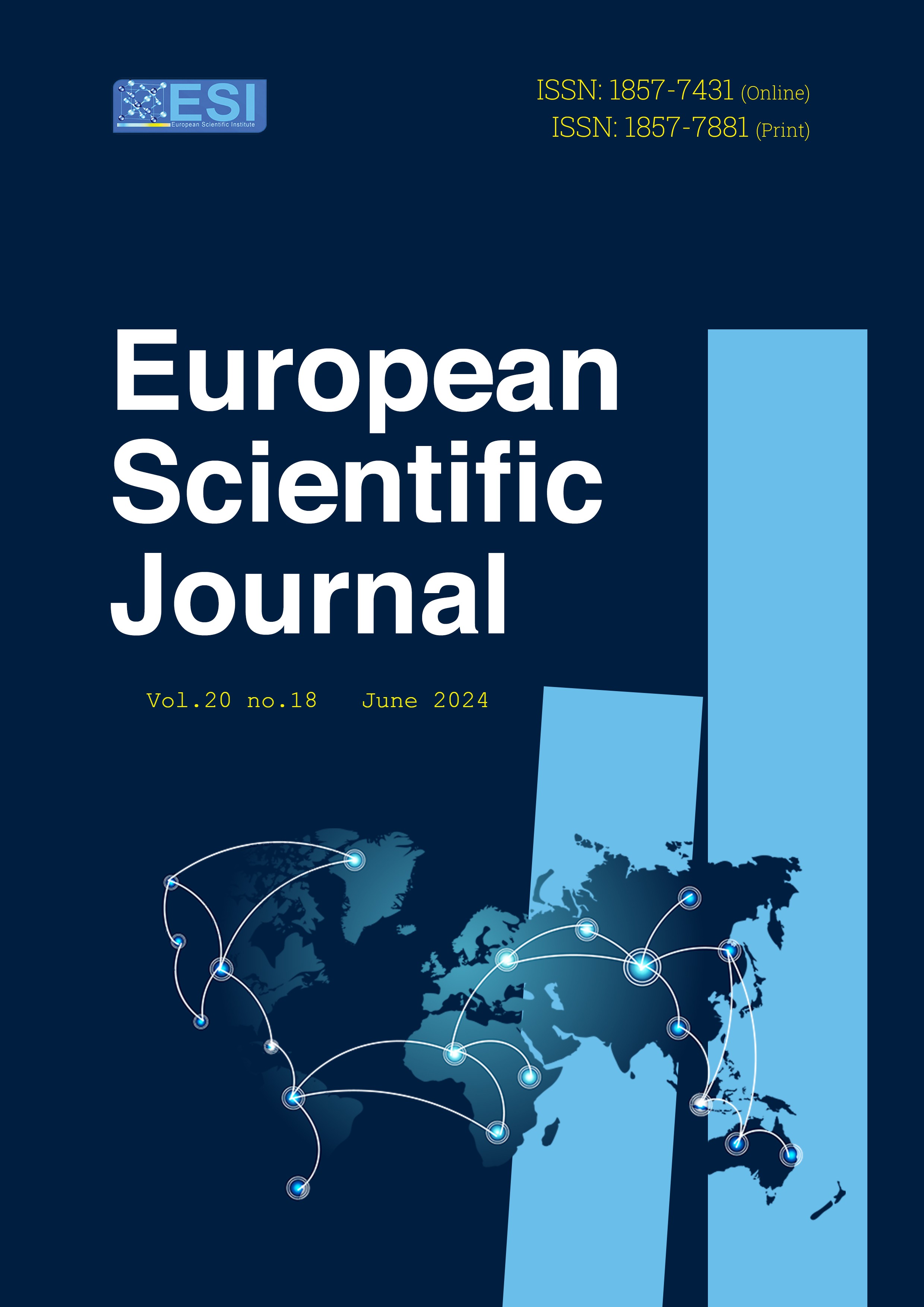Seasonal variation in contamination of fish flesh of smoked and dried Chrysichthys nigrodigitatus (Lacépède, 1803) with polycyclic aromatic hydrocarbons in the locality of Guessabo (Ivory Coast)
Abstract
Polycyclic aromatic hydrocarbons are organic contaminants, some of which are known to be toxic, carcinogenic and mutagenic for humans. These molecules are ubiquitous pollutants of the environment, and can contaminate foodstuffs such as fish. The aim of this study was to assess the level of polycyclic aromatic hydrocarbons contamination in the flesh of a species of freshwater fish, Chrysichthys nigrodigitatus, smoked and dried in the locality of Guessabo. The method used for the determination of these analytes in the matrices was high performance liquid chromatography with UV/Visible detector.
Results obtained indicate disproportionate contamination of Benzo(a)pyrene, Benzo(b)fluoranthene, Benzo(a)anthracene and Chrysene molecules depending on the mode of transformation and the season. The highest levels of contamination were recorded during the rainy season in the flesh of Chrysichthys nigrodigitatus smoked for Benzo(a)pyrene (10.39 ± 1.10 µg/kg), Benzo(b)fluoranthene (46.44 ± 3.77 µg/kg) and the sum of the PAH4 (59.88 µg/kg). These levels exceed the standard set by Ivorian regulations (5 µg/kg). In dried fish flesh, a low level of toxicity was recorded whatever the season. There were no significant differences between seasons for most of the molecules studied. The flesh of Chrysichthys nigrodigitatus dried is less contaminated than smoked Chrysichthys nigrodigitatus.
Downloads
Metrics
PlumX Statistics
References
2. Ahon, D. B. & Zean, G. M. (2020). Avian biodiversity in the Guessabo wetland, Centre-West of Côte d’Ivoire. Journal of Entomology and Zoology Studies; 8(6): 270-278.
3. Aké Assi, Y.A épse Datté. (2018). Evaluation of the risks of exposure to benzo(a)pyrene contaminating fish smoked in traditional high consumption ovens in the Abidjan area: the case of species of the genus Sardinella. Thesis. University of Nangui Abrogoua (Ivory Coast), 273 p.
4. Almulsi, E. (2011). Contamination par les hydrocarbures d’un poisson osseux : la sardine (Sardina pilchardus,walbaum, 1792), pêchée dans les baies d’Oran et Béni-Saf. Master's thesis. University of Oran (People's Democratic Republic of Algeria), 126 p.
5. Amoussou, B.A. épse Fagla. (2010). Study of polycyclic aromatic pollutant (PAH)-adrenergic receptor-membrane phospholipid interactions in adipose tissue. The national polytechnic institute of Lorraine, 160 p.
6. Baghdadi, M.D., Rachidi A., Maatouk, M., Noël L. & Barrijal, S. (2012). Determination of PAHs in fishery products by GC-MS on the Moroccan coast. Laboratory technologies –vol (7), N° 29 (90-98) p.
7. Botta F, Eva L, Albinet A. & Ughetto E. (2014). Origins of PAHs in aquatic environments: review of source identification methodologies applicable to the water sector and initial choice of appropriate characteristic profiles. Rapport INERIS, France, 46 p.
8. Boukari, B-S. (2017). Physico-chemical, nutritional and sensory characterization of smoked and smoked-dried fish produced in South Benin. University of Abomey-Calavi (Benin), Master's thesis, 89 p.
9. Chahin, A. (2010). Metabolic bioindicators of exposure of dairy ruminants to polycyclic aromatic hydrocarbons (PAHs). Thesis. Lorraine National Polytechnic Institute,196 p.
10. Dagnogo, K., Coulibaly, A., Kallo, V., Doumbia, M., Dongo, C.A., Boka, M.O., Djinou, B.A.H.P., Biego, G.H.M. & Dembele, A. (2022). Health risk associated with Polycyclic Aromatic Hydrocarbons (PAH) contamination of four species of fish braised and consumed in the District of Abidjan, (Côte d'Ivoire). Journal of Applied Biosciences, Vol 174: 18056-18068 p.
11. Dina, B.M. (2012). Pollution of the marine environment and human health: Measurement, assessment and impact of chemical and biological contaminants in fishery products at the Moroccan coast. Doctoral dissertation. Abdelmalek Essaadi University (Morocco), 184 p.
12. Djessouho D. O. C. (2015). Socio-economic analysis of smoking fish from small-scale maritime fisheries on the coast of Benin. Master's thesis. Higher Institute of Agronomic Sciences, food processing, horticulture and landscaping, 56 p.
13. Dovonou, F. E., Eninhou, F. S., Balogoun, C. K., Atchichoe, W. N., Mama, D. & Vandervaere, J-P,. (2023). Monitoring the physico-chemical parameters of the Agbado river, used to supply drinking water to the town of Savalou in central Benin. Journal of Applied Biosciences 187: 19747-19770.
14. FAO. (2019). The world situation on food and agriculture. Report, 28 p.
15. Kra, K.S. (2016). The development of fishing in Côte d'Ivoire: the case of continental fishing in the sub-prefecture of Guessabo. (EDUCI). Journal of tropical geography and Environment, number 1, pp 1- 9.
16. Ndadani, F. Z., Zkhiri, F., Idali, H. & Rachidi, A. (2016). Analysis of polycyclic aromatic hydrocarbons in fish products from the south Atlantic coast of Morocco. J.MAR.CHIM. HETEROCYCL. Vol 15, N°1, 6p.
17. Ndiaye, M., Diop A., Gago-martinez, A., Antonio,J. & Vazquez, R. (2012). Mussel contamination (Mytilus galloprovincialis) the coasts of the Dakar region by Polycyclic Aromatic Hydrocarbons (HAP). International Journal of Biological and Chemical Sciences. 6 (4): 1895- 1904 p.
18. Ndrianaivo, E.N. (2016). Optimising the production of smoked/dried fish “ trondro saly” from Madagascar. Thesis. University Antananarivo of Madagascar. 188 p.
19. Sene,W. , Fall. J , Loum ,A., Diago, M. , Sagne, M. , Diouf, A. , Diouf , N. , Jatta ,S. , Ndong D. , Pelebe , R.O. E. & Diouf .M . (2020). Effects of salting, fermentation and drying on the biochemical and microbiological quality of catfish hybrids (Clarias anguillaris X Clarias gariepinus) reared in Senegal. Life and earth sciences and agronomy. REV.RAMRES-Vol.08 Num.02. ISSN 2424-7235.
20. Shep, H., Fofana, B., Tanoh, T. F., Kouassi, K. & Djou, K. J. (2016). Framework investigation report artisanal sea fishing of Côte d'Ivoire, 78 p.
21. Traoré, O. D. (2016). Dosage of PAHs in smoked fish (Tuna). Master memory, University of Nangui Abrogoua (Côte d'Ivoire), 42 p.
Copyright (c) 2024 Aya Pauline Miessan, Yolande Amoin Aké Assi, Offianan André Touré, Gnamien Willy Taunin Gooré Bi

This work is licensed under a Creative Commons Attribution 4.0 International License.








